On Monday afternoon, Philadelphia Flyers beat reporter Sam Carchidi dropped a bit of a bomb on Twitter.
Chuck Fletcher basically said everyone is available in a trade except Claude Giroux. I have a feeling Carter Hart is untouchable, too. #Flyers
— Sam Carchidi (@BroadStBull) January 28, 2019
As our own Jim Parsons noted, hockey insider Bob McKenzie told TSN 690 in Montreal on Monday that while he doesn’t think Flyers general manager Chuck Fletcher “has an agenda that says, ‘I’ve got to get Shayne Gostisbehere out of town here,’” he does think “he’s also willing to listen on just about anybody.”
Given that Gostisbehere has unquestionably struggled this season — he has followed up a 65-point campaign with just 20 points so far in 2018-19 — I think he’s a great target for the Vancouver Canucks, who have one of the worst blue lines in the National Hockey League.
Gostisbehere Discussed on Sekeres & Price
On Tuesday, Matt Sekeres and Blake Price chatted about Gostisbehere with analyst Ray Ferraro on TSN 1040, who concluded “Gostisbehere would be a player of interest for me.”
Ferraro noted the 25-year-old has struggled defensively in his career.
“I would say a lot of [his challenges] stem from the fact that he doesn’t play very much break in his game. He doesn’t stop very much. He swoops and reaches a lot when he defends,” Ferraro said. “He gets beat because his skating isn’t able to bail him out. He gets overpowered a little bit. [But] he’s a terrific power play guy. He can really move the puck. He can shoot the puck.”
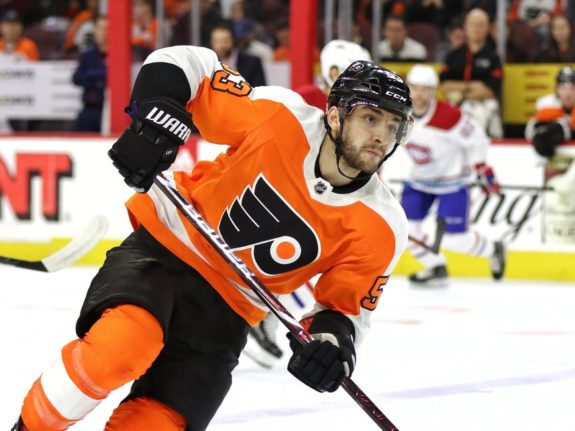
Regardless of defensive inefficiencies, Gostisbehere should be of interest to the Canucks, as Sekeres pointed out.
He’s 25-years-old. He makes four and a half million dollars and he had a 65-point, 13-goal season last year…I mean 65 points would nearly out-point the entire Canucks defense core from last year…If you are going to put a high pick or a prospect in play, this is a profile of a player that I would look at — an offensive driver from the back end, an elite power play guy, who’s 25-years-old.
Gostisbehere is signed for the next four seasons at just $4.5 million.
While Sekeres was exaggerating about last season’s 65 points being more than the entire Canucks blue line, he’s not entirely wrong. Gostisbehere’s 33 power play points were indeed more than the 32 combined points on the man advantage from all Canucks defensemen in 2017-18. His 65 points in all situations even accounted for 54 percent of the offence generated from the Canucks’ top eight defensemen, who combined for only 120 points last season.
The Fourth Period reported that it’s more likely the Flyers move Gostisbehere this summer (if they do at all), but with the Flyers apparently in sell mode leading up to the Feb. 25 trade deadline, now is as good a time as ever to take a crack at him.
Gostisbehere’s Value Will Never Be Lower
This season has not been kind to Gostisbehere. His 65 points last season were the fourth-most among NHL rearguards. This season, his 20 points in 48 games are tied for 45th-best.
Because of this drop in production, his average ice-time per game (ATOI) has gone from 21:27 last season to 20:12 so far in 2018-19. Gostisbehere has even been passed on the depth chart by Travis Sanheim as of late. The 22-year-old Sanheim’s 21:38 ATOI during the month of January is two and a half minutes more than Gostisbehere’s.
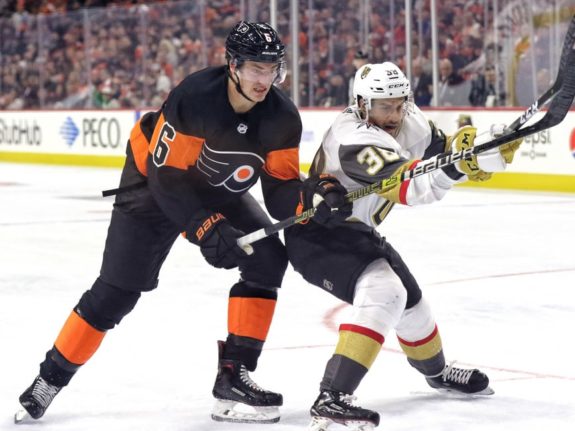
All of this tells me that Gostisbehere’s value right now is not very high. What do you do when another team’s good players are struggling? You buy low. Not that it will come cheap, mind you. But Vancouver needs to inquire.
Gostisbehere’s Struggles Have Been Overblown
Let’s take a closer look at Gostisbehere’s offensive numbers from this season and last, first at five-on-five.
| Shayne Gostisbehere 5v5 | TOI | G/60 | A1/60 | P/60 | CF/60 | GF/60 |
| 2018-19 | 749.27 | 0.16 | 0.24 | 0.8 | 58.62 | 2.4 |
| 2017-18 | 1287.9 | 0.19 | 0.37 | 1.12 | 56.32 | 2.7 |
It’s clear that Gostisbehere’s raw numbers have indeed declined, but not that significantly at five-on-five, from 1.12 points per 60 minutes (P/60) to .80 P/60 (A1 means primary assists, which I think are more helpful than total assists). The Flyers are actually generating more shot attempts per 60 minutes (CF/60) with him on the ice than they were last season, although they are converting on those chances less (down 0.3 GF/60).
This leads me to believe Gostisbehere’s drastic drop in production is due almost exclusively to his play on the man advantage. After all, the Flyers’ power play is last in the NHL right now at 12.9 percent. Last season, it operated at a 20.7 percent efficiency. Here are Gostisbehere’s power play numbers, on a per 60 basis, where I use Fenwick for instead of Corsi for because unblocked shot attempts provide a clearer picture when it comes to the power play.
| Shayne Gostisbehere PP | TOI | G/60 | A1/60 | P/60 | FF/60 | GF/60 |
| 2018-19 | 165.6 | 0.72 | 1.45 | 2.9 | 89.86 | 5.07 |
| 2017-18 | 271.62 | 1.55 | 1.99 | 6.85 | 93.44 | 9.94 |
Now we see a significant decline, at least in production.
Interestingly, it doesn’t appear the Flyers are having trouble getting shots through this season on their power play, at least not with Gostisbehere on the ice. It’s a decline, sure, but the difference of less than four unblocked attempts per 60 minutes of power play time is not a lot. Based on the drop from nearly 10 GF/60 last season to just over five this season, my guess was Flyers players are failing to capitalize on their chances.
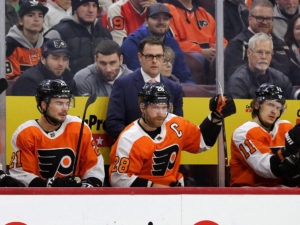
Indeed, that is the case. The Flyers’ shooting percentage on the power play this season is a league-worst 7.85 percent. This is despite them creating the fourth-most high danger scoring chances (HDCF) on the power play (108).
The point of all of this is twofold: first, at even-strength, Gostisbehere’s offensive numbers haven’t dropped very much, and second, while he has indeed struggled to produce on the power play, he shouldn’t solely be blamed.
A power play that is not converting is more of a systems issue than an individual player one. It’s not like all of a sudden Gostisbehere doesn’t have a strong shot or has lost his ability to distribute the puck. He would still be invaluable to a Canucks team without a true power-play quarterback, and whose power play is currently tied for the ninth-worst in the league, at 16.8 percent.
Canucks Blue Line Desperately Needs a Puck-Mover
Aside from Gostisbehere’s value on the power play, he would also help in the Canucks’ zone. We’ve already mentioned he’s not a great defender, but that’s when the other team has the puck. When Gostisbehere has the puck on his stick, he’s excellent at moving it out of the defensive zone with possession.
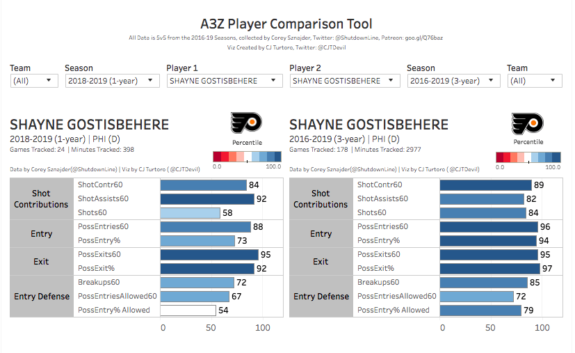
In the chart above, the possession exit percentage is the number of all exit attempts by that player that successfully left the zone, either by him carrying it or passing to a teammate.
The left chart shows Gostisbehere’s five-on-five data from 24 games this season, while the chart on the right has data from 178 games over the last two and half seasons. Even this season — where he has “struggled” — his possession exit percentage is in the 92nd percentile in the NHL, while the number of possession exits per 60 minutes is in the 95th percentile. That’s elite.
By contrast, the Canucks’ best defender at exiting the zone with possession this season has been Chris Tanev, at 72 percent, closely followed by Troy Stetcher, at 64 percent. In the last two and a half seasons, look at how much worse both of them have been compared to Gostisbehere.
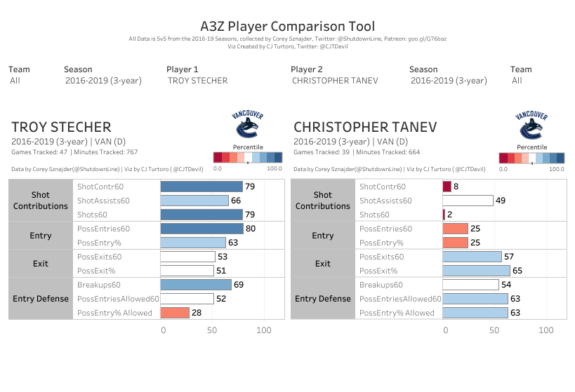
I’m not even going to bother showing Erik Gudbranson and Derrick Pouliot’s zone exit numbers, which are just atrocious. Why is this important? As the Jan. 23 loss to the Carolina Hurricanes showed, the Canucks have struggled mightily with their breakout. The Hurricanes’ forecheck gave them fits because they knew the puck was simply going to be thrown along the wall.
It might not be fair to pick on Pouliot and Gudbranson, but just look at the two failed zone exits below, especially the second one from Pouliot where he throws it straight to a waiting Dougie Hamilton.
The easy solution in that scenario would be to fire the puck off the glass and out, but then you’re just giving the puck back to the other team. They simply re-group and enter the zone again.
With a player of Gostisbehere’s ability, plays like the one above wouldn’t happen nearly as often. It’s something the Canucks hope to get with Quinn Hughes — a calm, cool and collected defenseman who can outmaneuver forecheckers and usually makes the right play out of the zone.
Likely Lots of Interest in Gostisbehere
The Canucks are certainly not the only team that might be interested in Gostisbehere’s services. As mentioned, it would also take a significant package to pry him out of Philadelphia. If he’s not moved by the deadline, the Canucks would do well to circle back to him at the NHL draft, when teams have more cap flexibility.
Adding him to the lineup would not only help with their power play and zone exits, it would help relieve some of the pressure that will likely be put on Hughes.